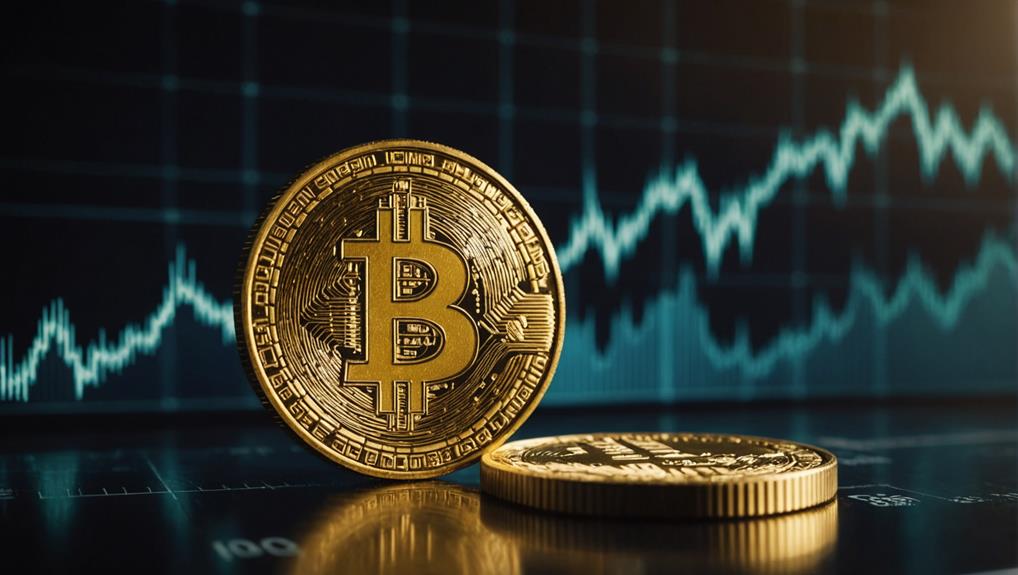Investing in digital gold requires a meticulous evaluation of the associated risks. The absence of regulatory oversight complicates dispute resolution and transparency in transactions, posing significant challenges for investors.
Cybersecurity threats, such as data breaches and phishing attacks, demand robust encryption and authentication measures to mitigate potential risks. Additionally, concerns like limited storage periods, investment caps, and counterparty risks can impact the safety and profitability of investments.
Effectively managing these diverse risks is essential for safeguarding investment portfolios.
Key Insights
- Lack of regulatory oversight can lead to market instability and challenges in dispute resolution.
- Cybersecurity threats like data breaches and phishing attacks require strong encryption and authentication.
- Limited storage periods can impact investment flexibility and require careful management.
- Counterparty risks include potential losses due to default or insolvency of the platform.
- Additional costs such as GST, storage, and transaction fees can affect overall returns.
Lack of Regulatory Oversight

In jurisdictions with inadequate regulatory oversight, digital gold investments pose significant risks to investors. The absence of robust regulatory frameworks can create market instability, leaving investors vulnerable to malpractices such as fraud and market manipulation.
Without clear rules and standards enforced by a governing body, disputes resolution and transaction transparency in digital gold transactions become challenging. This regulatory void not only jeopardizes individual investors but also undermines market confidence and trust.
Consequently, investors must exercise caution, conduct thorough due diligence, and be mindful of the potential risks associated with the lack of oversight when considering digital gold investments.
Cybersecurity Threats
As digital gold investments gain traction, they face significant cybersecurity threats, including data breaches, phishing attacks, and fraudulent activities. These risks can jeopardize sensitive information and lead to the loss of valuable assets if not properly addressed.
Implementing strong encryption protocols, two-factor authentication, and regular security updates, along with attentive monitoring of account activity, are crucial measures to protect against these vulnerabilities.
Data Breach Vulnerabilities
Safeguarding digital gold investments from cybersecurity threats requires addressing vulnerabilities that could lead to data breaches. These breaches can expose sensitive personal and financial information, putting investors at risk of unauthorized access and theft. Cyber threats often exploit weaknesses in online platforms that manage digital gold transactions. Mitigating these risks involves implementing robust security measures such as encryption, multi-factor authentication, and regular security audits. Investors must select platforms with strong cybersecurity protocols to ensure the protection of their digital assets.
| Risk | Impact | Mitigation |
|---|---|---|
| Data Breaches | Exposure of sensitive data | Encryption, multi-factor authentication |
| Unauthorized Access | Theft of digital assets | Strong passwords, regular audits |
| Compromised Information | Financial and personal loss | Secure platforms, comprehensive security measures |
Phishing and Fraud Risks
Phishing and fraud risks present significant cybersecurity threats to digital gold investors by employing deceptive tactics aimed at stealing sensitive information or funds.
These threats often materialize in the form of phishing attacks, which involve misleading emails or fake websites that mimic legitimate platforms to deceive investors.
Additionally, scammers may use fraudulent schemes to impersonate trusted organizations and extract confidential details.
To mitigate these risks, it is crucial for investors to exercise vigilance, verify the authenticity of platforms, and avoid sharing personal information in response to unsolicited communications.
Encryption and Security Measures
To safeguard digital gold investments against cyber threats like hacking and data breaches, robust encryption and security measures are imperative. Cutting-edge encryption technologies ensure the confidentiality and security of transactions and sensitive data.
Secure protocols such as SSL/TLS encryption protect digital gold holdings and transactions from unauthorized access. Adding an extra layer of security, multi-factor authentication mandates multiple forms of verification before granting access.
Regular security audits and updates help in identifying and addressing potential vulnerabilities promptly. Adhering to these stringent security measures significantly reduces the risk of cyber threats, safeguarding digital gold investments from potential losses and fostering a secure investment environment.
Limited Storage Periods

Investors engaging in digital gold investments must be cognizant of the storage periods associated with different platforms. These storage durations dictate how long assets can remain on a specific platform before investors are required to either liquidate or take delivery of their digital gold holdings.
Adherence to these time limits is crucial for maintaining investment flexibility and avoiding potential penalties. It is essential to understand the specific restrictions imposed by each platform to align with individual investment strategies effectively.
Here is a breakdown of the storage durations and restrictions for select platforms:
- Platform A: Requires liquidation after 1 year.
- Platform B: Delivery of assets is mandatory after 6 months.
- Platform C: Allows storage for up to 2 years with no restrictions.
Investors should thoroughly assess and comprehend these terms to ensure they align with their financial objectives in the long run.
Upper Investment Limits
Understanding the upper investment limits set by different platforms is essential when considering digital gold investments. These limits can impact the amount of gold an investor can purchase, particularly affecting those looking to invest significant sums. As these limits vary among platforms, investors must align their investment goals with these restrictions.
They play a crucial role in portfolio diversification, potentially limiting the ability to allocate funds as desired to digital gold. Adhering to these limits is key for effective portfolio management and optimizing investment performance in the digital gold market.
Counterparty Risks

Investors must stay vigilant about counterparty risks in digital gold investments, which involve the potential loss due to the default or insolvency of the platform or custodian safeguarding their assets. These inherent risks underscore the importance of mitigating strategies to protect investments effectively.
To mitigate counterparty risks, investors should consider the following factors:
- Reputation: Opt for platforms with a solid reputation and positive feedback from users to ensure reliability.
- Security Measures: Verify the implementation of robust security measures like encryption and multi-factor authentication to enhance asset protection.
- Financial Stability: Assess the financial robustness of the custodian or platform to ascertain their ability to withstand economic challenges.
- Regulatory Compliance: Choose custodians that comply with relevant regulations and industry standards to ensure a secure investment environment.
Technology Risks
Digital gold investments are exposed to technology risks like system failures, cyberattacks, and technical glitches, which can disrupt transactions and compromise security. Relying on technology infrastructure makes investors vulnerable to security breaches and data vulnerabilities, potentially resulting in unauthorized access, asset loss, and financial damage.
To safeguard investments, it is crucial to choose platforms with robust cybersecurity measures and proactive security protocols. Keeping security measures updated and staying informed about technological advancements are essential practices for risk mitigation.
Addressing technology risks is pivotal for upholding the security and integrity of digital gold investments, ensuring smooth transactions and protecting assets from malicious activities.
Absence of Interest

Digital gold investments have a notable drawback in their inability to generate interest income, unlike traditional savings accounts or bonds. This absence of periodic interest payments necessitates seeking alternative investments for income generation, adding a layer of complexity to financial planning.
Investors must carefully assess their risk tolerance, as the lack of guaranteed interest can potentially increase investment volatility. To mitigate this limitation, diversifying one's portfolio effectively can help offset the impact of the absence of interest from digital gold.
Understanding this fundamental characteristic is crucial for informed long-term financial decision-making, ensuring a comprehensive approach to wealth management.
Additional Costs
When investing in digital gold, it is important to consider additional costs such as GST, storage and delivery charges, and transaction fees. These costs can significantly influence your overall return on investment, making it necessary to understand the fee structures of digital gold platforms.
Proper assessment and management of these expenses can help investors optimize their returns and make more informed decisions.
GST and Fees
Investors engaging in digital gold transactions need to factor in a 3% GST along with additional charges like delivery and making fees, which can significantly impact the total investment cost. These extra expenses can eat into potential returns, so it's crucial to weigh them carefully. Being mindful of the various fees involved is essential for making well-informed investment decisions.
Here are key considerations:
- GST: A 3% Goods and Services Tax (GST) is levied on digital gold investments.
- Delivery Charges: Costs associated with physical gold delivery can add up.
- Making Charges: Expenses linked to the production and processing of gold items.
- Other Fees: Additional administrative or transaction fees may be enforced.
Understanding and accounting for these costs can help investors effectively manage their digital gold investments.
Storage and Delivery Charges
In addition to GST and making fees, storage and delivery charges play a significant role in the overall costs associated with digital gold investments. These charges can vary depending on the platform or service provider, impacting the total expense of your investment.
Storing digital gold in crypto wallets or cold storage (offline wallets) often incurs fees that are essential for proper digital asset management. Understanding and accounting for these storage and delivery charges is crucial for accurately estimating potential returns.
Investors should carefully review the fee structure to make well-informed decisions, as these costs directly affect the total expenses linked to digital gold investments, ultimately influencing the actual profitability and feasibility of such an investment.
Transaction Costs
Transaction costs play a significant role in digital gold investments, impacting overall returns by encompassing fees for buying, selling, and storing gold assets. These costs consist of various types of fees that investors need to consider:
- Buying Fees: These charges are incurred when investors purchase digital gold through a platform.
- Selling Fees: Costs associated with the liquidation of digital gold holdings.
- Storage Fees: Expenses related to securely storing digital gold assets, often charged on an annual basis.
- Platform Fees: Additional charges imposed by digital gold platforms for services such as maintenance, conversion, or other related activities.
It is essential for investors to monitor transaction costs to evaluate the profitability and efficiency of their digital gold investments. By understanding and comparing these costs across different platforms, investors can make well-informed decisions to ensure the viability and profitability of their investments.
Market Volatility

Market volatility in digital gold prices stems from a variety of factors, such as economic conditions, geopolitical events, and shifts in market sentiment. These fluctuations are driven by changes in global events and market conditions, leading to uncertainty that can affect investor confidence.
Despite being considered a safe-haven asset, digital gold is not immune to market volatility. Investors should be prepared for potential short-term losses and closely monitor price movements to make informed decisions.
Understanding and managing the risks associated with market volatility is crucial when investing in digital gold to mitigate unexpected financial impacts.
Conclusion
Investing in digital gold carries significant risks, including the absence of regulatory oversight, potential cybersecurity threats, and limitations on storage options. Additional concerns pertain to capped investment amounts, counterparty risks, and vulnerabilities in technology. Investors should carefully weigh the lack of interest accrual, possible extra expenses, and the inherent market volatility.
It is crucial for investors to have a thorough understanding of these risks and to manage them prudently to protect their investments and mitigate potential losses in the digital gold market.
The Gold Information Network
11900 Biscayne Blvd, Ste 127B, Miami, FL 33181
(305) 449-9094
https://goldinfo.net







